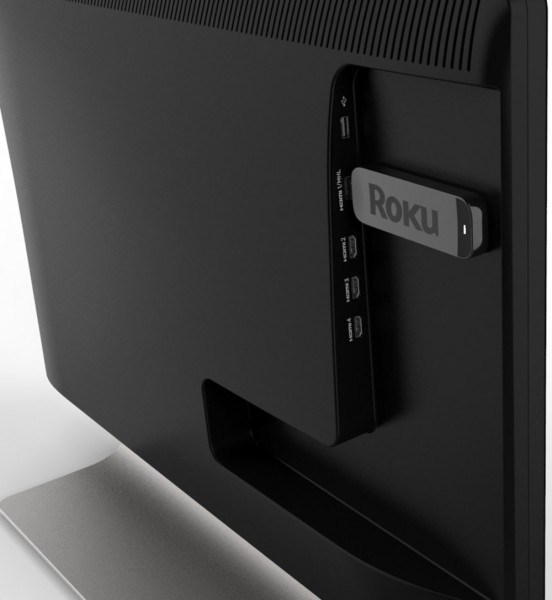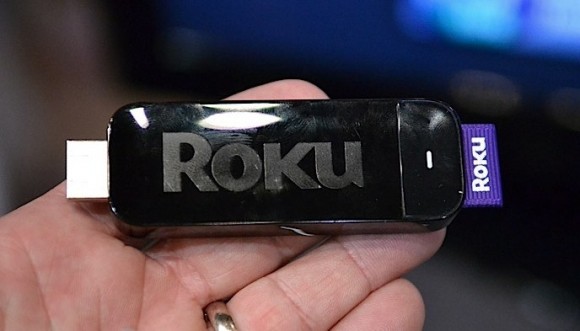
Roku intends to expand their digital media offerings later this year with the Streaming Stick — bringing Roku’s flavor of Smart TV capabilities to perhaps lower IQ sets. This doesn’t exactly mark the first time Roku has thought outside the box, having made their technology available for license in 2010. Yet, that initiative seems to have sputtered with apparently no HDTV takers and only a limited hardware run by Netgear. Whereas the Streaming Stick represents a more palatable hybrid approach for both potential partners and consumers alike.
The Roku Streaming Stick, slated for a late 2012 delivery, is described as the size of a typical USB thumb drive and contains just about everything that makes Roku a Roku, including processing and wireless capabilities in addition to their software experience. The relatively new MHL (Mobile High-definition Link) spec frees Roku of its current HDMI and power cables, with compatible HDTVs from Samsung and Toshiba already on the market. However, while at Sling, we similarly attempted to repurpose the HDMI connector for non-HDMI functionality… and it led to all sorts of user confusion. So I can imagine folks picking up the Roku Streaming Stick assuming they can simply plug it into any HDMI port and ending up frustrated, leading to increased Roku support costs and returns. Which is probably why Roku has also announced a partnership with Best Buy, who intends to bundle the Smart Stick with select MHL-capable Insignia-branded televisions — probably a simpler, cheaper, and all around less risky proposition than say the TiVo TV.
Of course a lot can happen between now and the end of the year. Plus, we don’t imagine Roku would cease development of their successful stand alone boxes. And GigaOm wonders if 2012 is the year Roku looks to sell (to Intel?). But, as a customer, what I’m looking for is more premium content, YouTube, and a refreshed UI to better manage the oodles and oodles of Roku channels.

they should worry about fixing the color space problem they have going on first.
good luck getting DD+ out of netflix with that thing.
MHl does support up to 7.1 audio pass-thru (and 1080p). The question is what can and will Roku integrate into such a small form factor.
but DD+ does not pass thru a toslink connection into an AVR. DD+ speck requires HDMI.
i have no idea if a TV with ARC will pass DD+ from this dongle onto an AVR.
Dave, you try to convince the normal Joe to plug this thing into his TV’s “MHL” port, then using the ARC port into his ARC enabled AVR that has to support DD+. Assuming that the MHL HDMI port is seperate from the TV’s ARC port. have fun.
Oh, I agree there’s plenty of opportunity for confusion here. But I also assume most with a full-on theater set up don’t pass audio through their TV and wouldn’t go with what I assume will be a lower-end Roku offering. And most manufacturers find success with the simple, mainstream, budget offerings. (How many are still happily watching SD content on HDTVs… without realizing it?) We still find ourselves in a massive state of flux and folks are throwing things at the wall to see what sticks.
I think Roku actually missed their 2011 numbers because they didn’t have a Qwikster channel…
What is the purposed served in announcing a product ‘late 2012’ that is a year from now. No wonder these products fail. I suppose I might buy this, but another company may announce to be released in 2013 a better gadget and I’d have to wait again….
Yeah, I’m not a big fan of pre-announcements – especially this far out. However, I suspect it’s timed to coincide with all sorts of tech news out of the annual Consumer Electronics Shows which gets started in a few days. Also, by announcing early they control the message (instead of waiting for us bloggers to scoop them with a FCC leak). Lastly, if Roku is shopping themselves around as GigaOm seems to think they want to generate a certain amount of (ongoing) hype and also let potential suitors know what sorts of innovative things they’ve got in the pipeline. Anyway, I’m still waiting on the Verizon FiOS TV iPad app demo-ed at CES 2011 that never shipped, along with the Verizon Slingbox hardware/service. And quite a few other things. So it goes.
Engadget handled the device at CES and I added one of their pics above. But, other than the prototype being a fingerprint magnet, we haven’t learned anything new.
Why didn’t Roku just use USB port for power like Always Innovating’s HDMI Dongle (http://www.theverge.com/2012/1/7/2690182/always-innovating-hdmi-dongle-android)? There are way more TVs with USB than MHL and those that don’t have a USB port, could always use a USB power adapter that’s as common as dirt.
Well, it’s more than power – it’s true I/O between the TV and the MHL device. USB doesn’t provide that sort of standard, whereas MHL is trying. Of course, trying doesn’t necessarily mean succeeding.